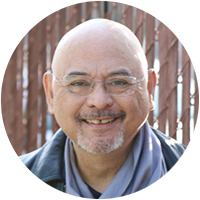Exploring Humanities and Social Sciences Online

Dom Magwili
CSUF Professor
Department of Asian American Studies
Online B.A. in Humanities and Social Sciences
Author of Legends from the First Hemisphere: The Infernal Promise
Dr. Magwili’s novel is also currently available in the Pollak Library at CSUF.
What are the key benefits of taking your course online, and how does it compare to in-person learning?
In-person learning versus online is like comparing apples and oranges. They are two different experiences with their own set of expectations. Each has benefits and is useful depending on the needs and goals.
In-person learning is very powerful. Learning is specific and effective. There is a direct, communal, and personal interaction. Its weakness lies in all that comes with brick-and-mortar teaching. Teachers get sick. Students face transportation issues. Because a class is only available geographically, access may be limited.
The benefit of going online is access. The internet gives us a global reach. I believe there are many stories in the Asian American film canon that are unknown to the rest of the world. They range from undiscovered historical events in Asian American history to the drama, comedy, and fantastical stories from the imaginations of Asian American filmmakers. Reaching a large audience is a worthy goal.
I aim to introduce this course to as wide an audience as possible. I hope this sparks an interest beyond the class and inspires students to pursue the subject matter independently.
How does the cohort model enhance the online learning experience, particularly in an Asian American Studies course?
The cohort model is the most efficient and effective way of teaching a group of students. Teaching students one-on-one is essentially tutoring. While that can work for the individual, I think it is inefficient. Working with a large group, sharing information, and being consistent with tasks and requirements helps make better use of resources and time.
""
What should students know to be successful in your online classroom?
Participate: My class requires participation to be successful. This is done through the required discussion boards. Submitting comments to questions that I provide and commenting on other students’ submissions is required. Achieving that requirement for the duration of the course is the challenge. Participation makes up 60% of the final grade. The remaining percentage is divided between weekly quizzes and a video paper.
Time Management: Manage time well. There are movies to watch and readings to review. See the films and complete the readings early in the week. Avoid the traffic jam close to the deadline.
What major themes or topics will students explore in your Asian American Studies course, and how will they apply this knowledge?
We will explore the presence of Asian American performing artists in American film and TV. We examine the negative stereotypes promoted throughout the years. We explore the long-term effects of these distorted images on the Asian American population and describe how these misrepresentations are self-promoted by unsuspecting filmmakers and producers.
We offer samples of films and videos created by Asian Americans and highlight the differences in results when a filmmaker is personally involved with the subject matter instead of being assigned a movie to film. We discuss different points of view and agendas.
Finally, in 2024, we examine how the media landscape has changed over the past few years. At the Academy Awards in 2021, the Asian American movie Minari was nominated for Best Picture. Everything Everywhere All at Once won Best Picture in 2022. The TV show with Asian American leads, Fresh Off the Boat, ran from 2015 to 2020. Does this mean the Asian American issues have been resolved? I think not. The final theme promoted in class is that the Asian American creative community must continue to reach for excellence.
Asian American filmmakers have been making films since 1916. We must tell our stories.
What are some potential career paths for students pursuing a degree in Asian American Studies or other HSS disciplines?
Starting from the broadest career possibilities, pursuing a degree in Asian American Studies or other HSS disciplines demonstrates a proven ability to complete academic requirements in communication, both verbal and written. It also confirms an ability to meet deadlines, complete tasks, and investigate new disciplines.
Career paths: These skills directly apply to any career. A degree in Asian American Studies or other HSS subjects certifies discipline, communication, and creative thinking appropriate to the sciences, history, languages, and social disciplines. Any profession benefiting from a focused, task-oriented individual who communicates well would welcome our graduates.
Moving on to Asian American Studies, I have a personal interest in the subject. I graduated from the University of San Francisco in 1968. They had just coined the phrase “Asian American” then. There was no course of study. In those days, I was a pineapple, a banana, or a coconut. I was brown on the outside and white on the inside.
My parents were immigrants from the Philippines. I was an American-born Filipino but had no conceptual idea what that was. What I thought of it in those days was negative. I was in acting school then and considered myself a white actor in an Asian body. My self-hatred was subtle and devastating.
In 1974, I connected with America’s first Asian American theatre company, the East West Players. It was Asian American Studies 24/7. Thinking back, I believe that in those days, Asian American theatre and Asian American Studies were working on the same material. Teachers needed content. EWP needed an audience. We wrote about family, history, and the confusion of being an Asian in America.
My discovery of myself, specifically, and Asian American Studies in general, was life-changing. I believe the goal of Asian American Studies is to ensure that our students do not look upon themselves with regret. I hope my presentation of Asian American history and stories will give students a view of the world that includes them.











